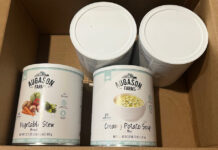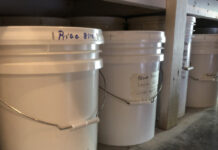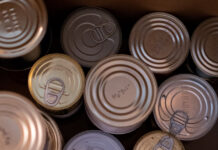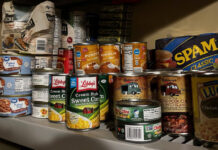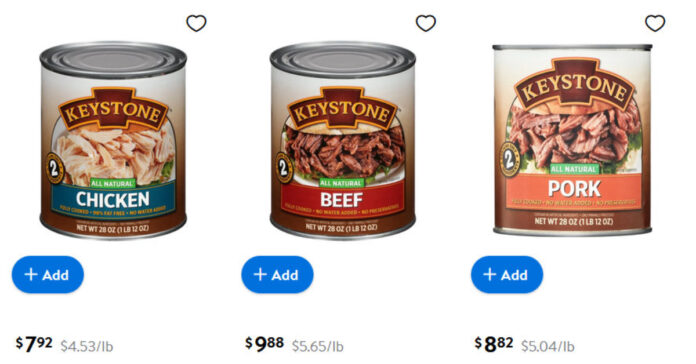
I was in a different town earlier this week, and I stopped by their Walmart to buy sugar to replenish my beekeeping supplies. (I feed sugar water to the bees in the early spring and late fall). Curiously, it was a better price-per-pound in the four-pound bags than in the ten-pound bags. I didn’t stop to wonder why. I just bought six four-pound bags.
Then I cruised the grocery section looking for sale items. When I transited the canned meat aisle, I almost fell over in shock. This store had Keystone canned pork. I had seen it online, but never in any physical store, so I added two of the big 28-ounce cans to my cart for our prepper pantry storage. (I still have not seen their ground beef in stores.)
The expiration date was in February 2029. The ingredients were pork and sea salt, that’s it. At $8.82 per can, the price worked out to about $5 per pound. Yes, I can get canned ham for $3.88 per pound and I’ve seen Spam for less, but the big Keystone can was less per pound than the Great Value pulled pork in barbecue sauce. Plus, it is not as heavily processed and is better meat. In hindsight, I wish I had bought more.
One can has 980 calories and 162 grams of protein. They claim it serves 14, but a two ounce serving of meat is a small serving. Depending on what you make and how hungry people are, I think you’d be better off with servings of four ounces each. But if you add it to a casserole, a soup, stew, or other dish with lots of other ingredients, I could see it serving ten or more.
Eating Canned Meat in a Survival Situation
If eating canned meat in a survival situation makes you think of some lone guy in the wilderness opening up a can of meat and cooking it over an open flame while still in the can, that’s the wrong approach. You will want to accompany your meat with lots of carbs, like a couple cups of cooked rice. That will give you the best combination of protein, fat and carbohydrates to fill your tummy and power you through the next day.
Rice is the best carb for preppers and should be staple food in your prepper pantry. It is easy to prepare—just boil water, add rice, and simmer. Rice is familiar to everyone and very palatable. It also can take on the taste of whatever is cooked with it, making it delicious with sauces. If the canned meat has juices in it, don’t pour the meat juice out, but mix it with the rice to make it taste even better.
Another carbohydrate option is powdered potato powder or granules rehydrated to make mashed potatoes. You could make meat pie with the mashed potato or eat as-is. You can also buy boxes of scalloped potatoes or even hash browns and cook them up. Another carb option is pasta, even just a brick of ramen. Eating your canned meat with a carbohydrate or starchy food will stretch the number of servings you get from a can of meat because it will provide the bulk of the calories.
Not Just Meat
Beside canned meat, try mixing a can of chili or beans with rice. That can produce a filling, tasty meal in a single pot. Or, think of fried rice; it’s just an egg, a few pieces of meat (or not) and some vegetables mixed together with cooked rice and fried in a large pan. Almost any source of protein will work.
Even most pasta dishes with meat sauces are a useful way to include some meat in your meal while most of the calories come from carbs.
Soups made with rice or barley, and stews made with potatoes are another variation on this trend. Both soups and stews can me made with fish, including canned tuna.
Another Great Source of Carbs
Don’t forget bread, one of the most important sources of carbs for most of European history. There is a reason the Bible calls it the Staff of Life. But how can you make bread in a survival situation if you don’t have an oven? There are multiple ways.
For example, you can cook a loaf of bread over a fire in a Dutch oven or a frying pan with a lid. If you have a frying pan but no lid, you can still make fry bread or bannock. If you lack the oil to fry the bread, you can make a bread product not unlike pizza dough by covering the pan with dough and flipping it when the bottom becomes brown. You can also make thinner breads, like tortillas, naan, or pita.
If you don’t have a frying pan but you have a small pot or even a metal cup, you can place the dough in it and use the pan or cup as a bread pan and cook it in the coals of the fire.
If you have no pan at all, you can wrap the dough around a stick and cook it over coals, much like you might roast a marshmallow in happier times. (Just expect it to take longer.) You can also place a small flat loaf or patty in the hot ashes, which is where the term “ash cake” came from.
Once baked, you can eat your bread with your meat, or pile your meat onto it, like you would a sandwich or burger. You can also make dumplings by rolling out a circle of dough and then placing the meat inside. Dumplings can be cooked multiple ways, including baked, steamed, or boiled. Again, the idea is to make a little meat go a long way.
Storing Flour Versus Wheat
Baking bread requires flour, which you either have to store or have grain from which you can grind your own. The problem with flour is it doesn’t last well in storage. We rotate our white flour, so we usually have less than 25 pounds on hand. Instead, we have hundreds of pounds of wheat in five-gallon pails, most of it hard red winter wheat but also some soft white wheat and Bronze Chief from Wheat Montana.
It takes some infrastructure to produce bread in a post SHTF scenario. First, you need to store or grow wheat or corn, and growing it takes even more infrastructure. Then you have to grind wheat into flour. We have an electric mill, but we also have the hand-crank Country Living Grain Mill and a host of spare parts. Plus, we have a backup no-name hand-crank mill that has been in its box since before Y2K. With any luck, it will remain in there.
But there is more to bread than four. You need a leavening agent, usually yeast for bread and baking powder for quick breads, muffins and pancakes. You have to store those as well, or learn to make and maintain the “mother” used to make sour dough bread.
And while you can do just fine with Dutch oven bread, a wood-fired pizza oven would be a nice touch. I don’t have one, but I expect we would try to build one outdoors in a long-term grid down scenario. It would be useful for far more than baking bread.
Prepare Now to Prevent Starvation Later
I’ve always stressed food storage on this blog, but I am re-emphasizing the importance of having food on hand for the coming bad times. Besides storing food, you need to know how to use it. Practicing to cook, bake, or prepare prepper meals is a good start. To do that, you may need some recipes. Take advantage of your internet connection and search out recipes or videos on how to make bannock, fry bread, pita, and how to cook a loaf of bread in a Dutch oven. Google “How to make bread over a camp fire” for more details.

